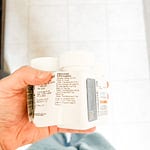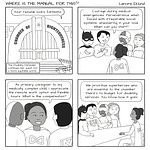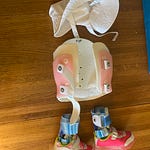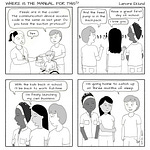Toby Lunstad was an occupational therapist and manager when she realized her daughter Addilynn’s needs were significant enough that she needed to give up employment. Toby had run out of paid leave and was having to constantly correct her daughter’s hired caregivers, so she didn’t feel safe leaving Addilynn with them to go back to work.
That was three years ago and Addilynn has blossomed under the focused care of her mother.
“She is doing way better,” Toby tells Medical Motherhood, “even friends that we don’t see a lot have noticed a difference, even in her affect. She’s way less stressed out. It hasn’t been easy though.”
The family now relies entirely on Addilynn’s mechanic dad, Shawn, working long days and weekends in his auto shop. He has to make one income that can pay for the health insurance Toby gave up, as well as the rest of the bills.
Toby is now campaigning for legislation in North Dakota that would allow parents and guardians like her to be paid for their minor child’s Medicaid in-home services. She has an email list 50 people strong and the bill, SB 2276, sailed through North Dakota’s Senate on a unanimous vote Feb. 14. Next, it has to pass the House before the legislative session is scheduled to end April 28.
North Dakota is one of two states in the nation, according to a recent study, that as of November 2020 had no paid family caregivers, the other one being Alaska. During the COVID-19 federal public health emergency, several states used Medicaid flexibilities authorized by the Trump and Biden Administrations to allow legal guardians (usually parents) to be paid providers. North Dakota was not one of them.
Toby said she started campaigning on the new legislation last September and was prepared for pushback that so far has not materialized. Mostly, says the central North Dakota resident, the response she’s gotten from state senators is: “Why isn’t this a thing; why aren’t people able to do this already?”
But, she says, the biggest hurdle remains the budget.
“They’re just really hesitant because nobody knows how much it will cost,” Toby says.
A fiscal note, presented by North Dakota’s Developmental Disabilities Division Director Tina Bay, shows an estimated annual cost of $8.1 million for 320 participants. North Dakota, with a population of about 775,000 people, has about 6,000 people on its Home and Community Based Services (HCBS) waivers. SB 2276 would allow paid family caregivers across the age spectrum, not just to minors, at a daily rate of $150.38, five days per week. School-aged children would be eligible for half-days.
That restriction frustrates Toby, who homeschools her child due to the increased incidents of seizures under the stress of public school. But she says she intends to go back to the legislature in future years to combat the reduced payment.
As many state legislatures budget based on bienniums — every two years — the projected cost to the state of the program for 2025-27 is $11.5 million, with another $12.8 million from the federal government. Since the program has an anticipated start date of July 2024, that would be the program’s first full biennium.
Toby says that is about as much state money as was transferred out of the DD division’s budget recently due to unused caregiver hours.
“Because there’s nobody to hire,” she says is the reason the hours weren’t used, “and the ones that you do get to hire are not very good most of the time.”
A study released last month in The Journal of Pediatrics shows a three-year retention rate of just 9 percent for paid in-home care providers in Colorado. In contrast, paid family providers (which has been an option in Colorado for many years) have an 82 percent retention rate. The study examined Colorado’s Certified Nursing Assistant program, rather than an attendant care program like North Dakota’s, which would not require a certification.
Toby says care provider agencies are also asking the legislature for more money this year for recruitment and retention.
“The agencies are being asked: ‘Where are you going to find the people?’ – They don’t have answers, so we’ve been trying to capitalize on that,” Toby says: “‘We are! We are the people who can be paid!’”
(Story continues below) Read more from North Dakota’s former Medicaid Director Caprice Knapp on what the state is doing with American Rescue Plan Act funds, including supports for family caregivers, in a National Academies panel discussion last June:
Every state has its own idiosyncratic blend of Medicaid waivers and North Dakota is no different. For children, it has four 1915(c) waivers, one of which serves people of all ages. According to KidsWaivers.org, all of them waive parental income. The state also has a 1915(i) program for autistic children ages 15 and younger. Toby says the eligibility criteria for the paid parent caregiver program is yet to be worked out but would be based on the child’s annual assessment.
“It will really depend on the needs of the individual,” Toby says. “Being on the autism waiver will not exclude them from potentially be able to access this service option, their level of care will determine it.”
Toby says her group — which has assistance from North Dakota’s Family Voices chapter and its Protection and Advocacy office — wanted the legislation to encompass coming changes and expansions to its waiver programs.
The state has been working to expand access to HCBS — and relocating participants away from institutionalized settings — after a recent settlement agreement with the U.S. Department of Justice. The DOJ opened the investigation in 2015 after receiving complaints from disabled adults who said they “were forced to enter, or were at serious risk of entering, nursing facilities to receive necessary services.”
Toby says it’s not unusual for North Dakota families to get turned away for services — even for significant needs — and not appeal or reapply.
“Our waiver definitely needs some improvement,” Toby says. But for the paid parent caregiver option, she hopes: “We’re not going to have to fight for this again. It’s just going to always be there.”
The next stage for SB 2276 is a March 8 hearing in the House. Forty-three of North Dakota’s 47 senators, including the bill’s sponsors, are Republican. Only 12 of the 94 representatives in the House are Democrats.
The bill’s language is 22 lines long and defines the service parents could be paid for as “care exceeding the range of activities a legally responsible individual would ordinarily perform in the household on behalf of an individual without extraordinary medical needs, and which is necessary to assure the health and welfare of the individual and avoid institutionalization.”
“We kept it simple on purpose,” Toby says. “We don’t want to have to jump through a bunch of hoops.”
Read more: Learn about the Oregon legislature’s efforts on paid parent legislation, including my testimony in favor, in this piece from last month:
Tune in to XRAY FM radio this Wednesday at 11 a.m. to listen to an hourlong discussion on paid parent caregiver legislation in Oregon as part of their annual Amplify Women celebration. Broadcasting online or in Portland at 107.1 FM and the North Oregon Coast at 91.7 FM. Next week’s edition of Medical Motherhood will feature a recap of the discussion.
Medical Motherhood’s news round up
Snippets of news and opinion from outlets around the world. Click the links for the full story.
• From PBS: “Why Oregon is the worst-ranked state for youth mental health”
[…]there's an organization called Mental Health America, and every year they put out annual survey ranking how states provide care to mental illness and how severe the crisis is. And Oregon, unfortunately, ranks dead last in the country as far as young people who are struggling with their mental illness and their access to care. It's the highest rate of young people in this country with one serious depressive episode. It is the third highest number of children with substance abuse disorders and ranks 42nd in the country for those children with those depressive episodes not getting care.
And so there are a bunch of reasons why this happened. A recent state audit looked at several different factors staffing shortages, poor data, and just overall lack of beds. We, in fact, in our reporting found that in the entire state, there are only 40 beds for the most acute children who need this kind of care.
And there's also this issue of Oregon being a rural state. I mean, there are several major cities, and the majority of people live in those cities, but a lot of the state lives in places where it's hours to care. Mental health officials tell us once they discharge those people, they're going back to communities where there may not be a single psychiatrist in town to help them.
[The story goes on to talk about Youthline, which is a peer messaging system that is making an impact on this crisis. Reach it at 877-968-8491 or by texting teen2teen to 839863.]
• From New Atlas: “Classroom robot helps keep kids with learning disabilities on track”
Students with learning disabilities (LD) struggle with particular skills like reading, writing, or mathematics and often require additional, individualized support to fill educational gaps. A team of researchers and experts has found that a cute little robot may help children with learning disabilities stay focused.
[…]The brainchild of scientists Dr Pouyan Ziafati and Dr Aida Nazarikhorram, QT was the first robot developed specifically as a tool to assist children with ASD [autism spectrum disorder]. It can gesture with its head and arms, display facial expressions, and speak.
[…]The study showed that the students who partook in sessions with QT engaged in fewer off-task behaviors and showed greater engagement. The students perceived the robot as friendly, intelligent, and enjoyable and would be willing to engage with QT in future sessions.
Feedback from the instructors demonstrated that, to a large degree, they found the robot’s intervention effective and helpful in maintaining the students’ focus and engagement.
“There is definitely a great potential for using robots in the public education system,” said Dr Kerstin Dautenhahn, a professor of electrical and computer engineering and an author of the study. “Overall, the findings imply that the robot has a positive effect on students.”
Further studies using QT are planned to further investigate the utility of robot-assisted learning for children with learning disabilities.
• From STAT (Opinion): “Fixing U.S. public health will require a health-systems revolution — and for physicians to take a backseat”
[…]While the clinical frameworks that characterize medical training are appropriate for the one-to-one encounters of patient care, misapplying them to the population-level problems of public health leads to a failure to effectively anticipate and address the social conditions upon which disease and disability feed. This, in turn, fuels a top heavy, reactive national health policy that prioritizes profitable medical treatment rather than cost- and life-saving prevention via community-based social services. Declining life expectancy in the U.S. — now at its lowest in nearly two decades — reflects the consequences of this policy choice.
[…]the most effective public health systems are designed and implemented from the bottom up. They see world “from below” — that is, from the most marginalized positions in a society where the obstructions to health are most apparent and oppressive. Enabling this kind of approach requires listening to, valuing, and directly involving individuals with lived experience of how and who the existing systems are failing: people who are unhoused, elderly, immunocompromised, migrant agricultural workers, racialized, those identifying as LGTBQ+, those living with histories of incarceration, and otherwise vulnerable groups. […]
Medical Motherhood brings you quality news and information each Sunday for raising disabled and neurodivergent children. Get it delivered to your inbox each week or give a gift subscription. Subscriptions are free, with optional tiers of support. Thank you to our paid subscribers!
Follow Medical Motherhood on Facebook, Twitter, TikTok, Instagram or Pinterest. The podcast is also available in your feeds on Spotify and Apple Podcasts. Visit the Medical Motherhood merchandise store.
Do you have a story to share or an injustice that needs investigation? Tell me about it and it may become a future issue.















